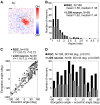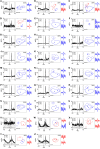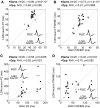Spatiotemporal receptive field structures in retinogeniculate connections of cat
- PMID: 24367299
- PMCID: PMC3856685
- DOI: 10.3389/fnsys.2013.00103
Spatiotemporal receptive field structures in retinogeniculate connections of cat
Abstract
The spatial structure of the receptive field (RF) of cat lateral geniculate nucleus (LGN) neurons is significantly elliptical, which may provide a basis for the orientation tuning of LGN neurons, especially at high spatial frequency stimuli. However, the input mechanisms generating this elliptical RF structure are poorly defined. We therefore compared the spatiotemporal RF structures of pairs of retinal ganglion cells (RGCs) and LGN neurons that form monosynaptic connections based on the cross-correlation analysis of their firing activities. We found that the spatial RF structure of both RGCs and LGN neurons were comparably elliptical and oriented in a direction toward the area centralis. Additionally, the spatial RF structures of pairs with the same response sign were often overlapped and similarly oriented. We also found there was a small population of pairs with RF structures that had the opposite response sign and were spatially displaced and independently oriented. Finally, the temporal RF structure of an RGC was tightly correlated with that of its target LGN neuron, though the response duration of the LGN neuron was significantly longer. Our results suggest that the elliptical RF structure of an LGN neuron is mainly inherited from the primary projecting RGC and is affected by convergent inputs from multiple RGCs. We discuss how the convergent inputs may enhance the stimulus feature sensitivity of LGN neurons.
Keywords: cat; cross-correlation; lateral geniculate nucleus neuron; receptive field; retinal ganglion cell.
Figures









Similar articles
-
Two classes of single-input X-cells in cat lateral geniculate nucleus. II. Retinal inputs and the generation of receptive-field properties.J Neurophysiol. 1987 Feb;57(2):381-413. doi: 10.1152/jn.1987.57.2.381. J Neurophysiol. 1987. PMID: 3559685
-
Relationship between the Dynamics of Orientation Tuning and Spatiotemporal Receptive Field Structures of Cat LGN Neurons.Neuroscience. 2018 May 1;377:26-39. doi: 10.1016/j.neuroscience.2018.02.024. Epub 2018 Feb 23. Neuroscience. 2018. PMID: 29481999
-
Orientation bias of neurons in the lateral geniculate nucleus of macaque monkeys.Vis Neurosci. 1990 Dec;5(6):525-45. doi: 10.1017/s0952523800000699. Vis Neurosci. 1990. PMID: 2085469
-
Mapping the primate lateral geniculate nucleus: a review of experiments and methods.J Physiol Paris. 2014 Feb;108(1):3-10. doi: 10.1016/j.jphysparis.2013.10.001. Epub 2013 Nov 21. J Physiol Paris. 2014. PMID: 24270042 Free PMC article. Review.
-
The multifunctional lateral geniculate nucleus.Rev Neurosci. 2016 Feb;27(2):135-57. doi: 10.1515/revneuro-2015-0018. Rev Neurosci. 2016. PMID: 26479339 Review.
Cited by
-
Analytic Model for Feature Maps in the Primary Visual Cortex.Front Comput Neurosci. 2022 Feb 4;16:659316. doi: 10.3389/fncom.2022.659316. eCollection 2022. Front Comput Neurosci. 2022. PMID: 35185503 Free PMC article.
-
Directional Preference in Avian Midbrain Saliency Computing Nucleus Reflects a Well-Designed Receptive Field Structure.Animals (Basel). 2022 Apr 28;12(9):1143. doi: 10.3390/ani12091143. Animals (Basel). 2022. PMID: 35565569 Free PMC article.
-
Influence of Aging on the Retina and Visual Motion Processing for Optokinetic Responses in Mice.Front Neurosci. 2020 Dec 1;14:586013. doi: 10.3389/fnins.2020.586013. eCollection 2020. Front Neurosci. 2020. PMID: 33335469 Free PMC article.
-
Synchrony of Spontaneous Burst Firing between Retinal Ganglion Cells Across Species.Exp Neurobiol. 2020 Aug 31;29(4):285-299. doi: 10.5607/en20025. Exp Neurobiol. 2020. PMID: 32921641 Free PMC article.
-
A method for single-neuron chronic recording from the retina in awake mice.Science. 2018 Jun 29;360(6396):1447-1451. doi: 10.1126/science.aas9160. Science. 2018. PMID: 29954976 Free PMC article.
References
LinkOut - more resources
Full Text Sources
Other Literature Sources
Miscellaneous

